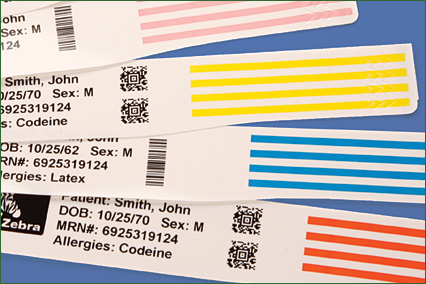Enhancing Security: The Relevance of Patient Identification Bands in Medical Care
In the realm of medical care, the efficiency of client recognition bands can not be overemphasized, as they serve as a fundamental protect against misidentification and subsequent mistakes. As we discover the diverse function of these bands, it comes to be noticeable that their relevance expands past mere recognition, raising concerns concerning best techniques and future technologies in patient security.
Introduction of Person Recognition Bands
Person recognition bands play an important duty in making sure the safety and security and accuracy of patient care in health care settings. These bands, commonly used on the wrist or ankle joint, offer as a critical tool for verifying person identity, thereby reducing the threat of mistakes in treatment, drug management, and other health care procedures. Made from sturdy products, individual recognition bands typically include crucial info such as the person's name, day of birth, medical record number, and barcodes or QR codes for scanning.
The application of client identification bands is important in numerous medical care settings, consisting of hospitals, outpatient centers, and long-term treatment establishments. They add to a methodical technique in patient administration, allowing medical care experts to rapidly and properly determine individuals, particularly in high-pressure circumstances where swift decision-making is crucial.
In addition, using these bands is straightened with governing requirements intended at boosting person safety - Patient Identification Band. By making certain that each patient's information is readily easily accessible and conveniently proven, doctor can maintain a high standard of care, lower the occurrence of unfavorable events, and promote a culture of safety within health care organizations
Benefits of Accurate Identification
Exact recognition is fundamental to enhancing person security and care quality in healthcare setups. It acts as the first line of protection versus mistakes that can result in adverse person outcomes. By making certain that each person is appropriately determined through trusted ways, such as patient recognition bands, doctor can considerably minimize the risk of misidentification, which can result in inappropriate therapies, medication mistakes, and even medical mix-ups.
Additionally, accurate individual recognition assists in efficient communication amongst health care teams. When all team members can consistently recognize individuals, they can share critical info a lot more efficiently, bring about far better coordination of care. This is particularly important in emergency situation circumstances where timely treatments are important.
In addition, accurate recognition supports compliance with governing criteria, therefore reducing the danger of legal consequences for health care centers. It cultivates trust in between individuals and health care service providers, as patients feel a lot more secure recognizing that their identifications are being protected.

Usual Difficulties Faced
Ensuring reliable patient recognition in medical care settings provides an array of difficulties that can endanger safety and care quality. Individuals might get here in a state of confusion or distress, making precise recognition difficult.
Another obstacle is the dependence on human consider recognition treatments. Healthcare specialists might inadvertently misinterpret or forget recognition protocols, particularly in high-stress environments such as emergency divisions. This can result in mistakes, consisting of the administration of inaccurate treatments or drugs.
Technical problems additionally posture obstacles. Digital health record (EHR) systems are designed Learn More to streamline patient recognition, system failures or individual mistakes can interfere with the procedure. The physical layout of client ID bands can lead to readability issues, particularly in cases where bands are harmed or covered.
Last but not least, irregular training among personnel pertaining to recognition methods can result in voids in expertise and method. Attending to these obstacles is essential for boosting person security and guaranteeing that identification bands offer their desired function properly.
Best Practices for Implementation
To properly carry out client recognition bands in health care settings, companies must adopt a diverse method that focuses on standardization, training, and technology combination. Standardization entails developing clear protocols for the style, application, and use identification bands throughout all divisions. This guarantees uniformity and minimizes the danger of mistakes linked to variations in band types or identifying techniques.


Training is essential for all medical care personnel to ensure they recognize the significance of accurate patient recognition, exactly how to properly review and apply recognition bands, and the procedures to adhere to in situation of inconsistencies. Regular workshops and refresher course programs can reinforce this knowledge and advertise a culture of safety.
Modern technology combination plays a crucial duty in improving the efficiency of individual recognition bands. Making use helpful resources of barcode scanning or RFID technology can enhance the recognition process, permitting real-time verification of person identifications. Furthermore, electronic health document systems should be set up to consist of alerts for inequalities between the recognition band and individual data.
Future Trends in Patient Security
As medical care proceeds to evolve, the emphasis on client safety is most likely to increase, driven by advancements in innovation and a better understanding of systemic dangers. Arising trends suggest a shift towards more integrated systems that take advantage of information analytics, man-made intelligence, and machine knowing to enhance person identification procedures. These modern technologies can help recognize potential safety and security problems before they rise, thereby minimizing mistakes associated with misidentification.
In addition, the implementation of blockchain modern technology may transform how patient data is securely shared among health care suppliers, making certain that recognition bands are regularly precise and updated. This will certainly not only improve patient safety but likewise promote seamless communication throughout multidisciplinary groups.

In addition, the expanding concentrate on individualized medication is expected to affect person safety protocols. By integrating market and hereditary info right into identification systems, medical care professionals can tailor treatments better, reducing the dangers of negative reactions due to misidentification.
Verdict
In conclusion, person identification bands offer as a crucial component in boosting safety and security within medical care settings. Inevitably, find the continued focus on robust recognition procedures will add to enhanced client outcomes and overall safety and security in medical care settings.
In the world of healthcare, the efficiency of patient identification bands can not be overstated, as they serve as a basic protect against misidentification and subsequent mistakes.Person recognition bands play a crucial duty in making certain the security and precision of client treatment in healthcare settings. Made from sturdy materials, individual identification bands usually consist of important details such as the patient's name, day of birth, clinical record number, and barcodes or QR codes for scanning.
By making certain that each client is properly identified via dependable ways, such as patient identification bands, healthcare companies can dramatically lessen the risk of misidentification, which can lead to unacceptable treatments, medication errors, and even surgical mix-ups.
In verdict, person recognition bands serve as an essential part in enhancing security within medical care environments. Patient Identification Band.
 Lark Voorhies Then & Now!
Lark Voorhies Then & Now! Anthony Michael Hall Then & Now!
Anthony Michael Hall Then & Now! Jennifer Love Hewitt Then & Now!
Jennifer Love Hewitt Then & Now! Kenan Thompson Then & Now!
Kenan Thompson Then & Now! Mary Beth McDonough Then & Now!
Mary Beth McDonough Then & Now!